Yamaha DT230 N 2001 Owner's manual
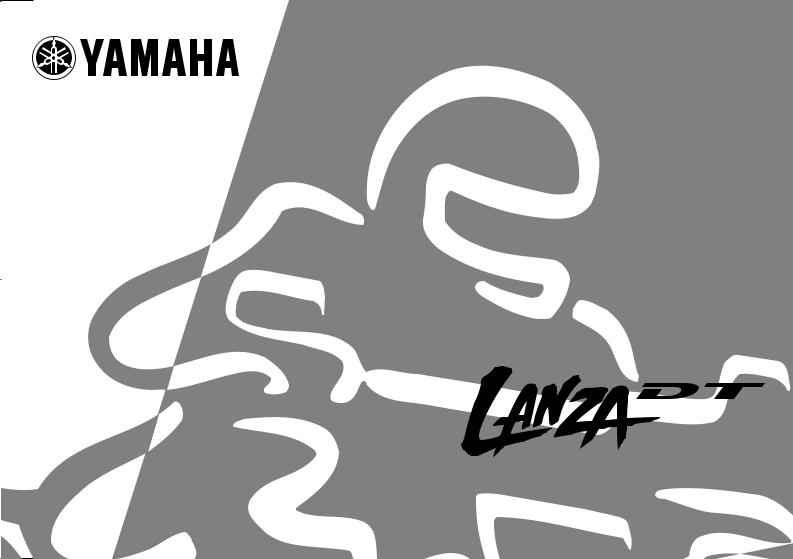
OWNER’S MANUAL
DT230(N)
4TP-28199-21

EAU00000
INTRODUCTION
Congratulations on your purchase of the Yamaha DT230. This model is the result of Yamaha’s vast experience in the production of fine sporting, touring, and pacesetting racing machines. It represents the high degree of craftsmanship and reliability that have made Yamaha a leader in these fields.
This manual will give you an understanding of the operation, inspection, and basic maintenance of this motorcycle. If you have any questions concerning the operation or maintenance of your motorcycle, please consult a Yamaha dealer.
1
2
4
5
6
7
8
9
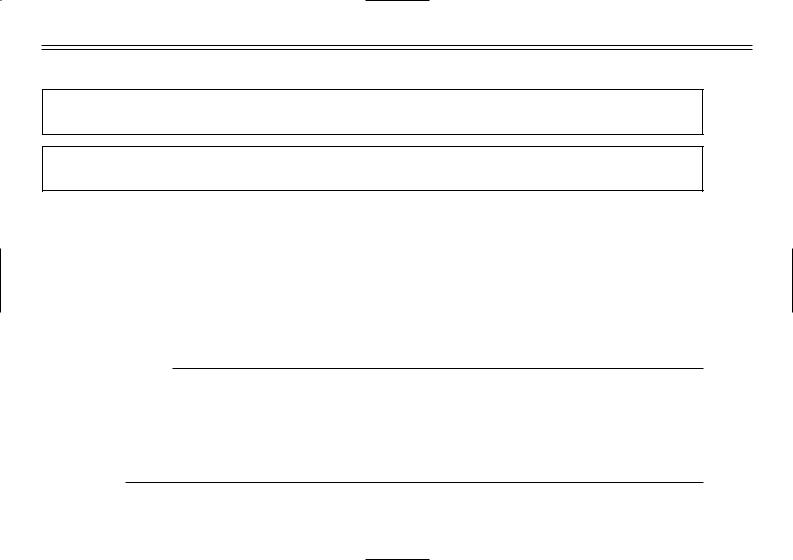
EAU00005
IMPORTANT MANUAL INFORMATION
Particularly important information is distinguished in this manual by the following notations:
1
2
3
4
5
6
7
8
Q |
INVOLVED!The Safety Alert Symbol means ATTENTION! BECOME ALERT! YOUR SAFETY IS |
wFailure to follow WARNING instructions could result in severe injury or death to the motorcycle operator, a bystander, or a person inspecting or repairing the motorcycle.
cC |
A CAUTION indicates special precautions that must be taken to avoid damage to |
|
the motorcycle. |
|
|
|
|
NOTE: |
A NOTE provides key information to make procedures easier or clearer. |
|
|
NOTE:
8This manual should be considered a permanent part of this motorcycle and should remain with it even if the motorcycle is subsequently sold.
98Yamaha continually seeks advancements in product design and quality. Therefore, while this manual contains the most current product information available at the time of printing, there may be minor discrepancies between your motorcycle and this manual. If you have any questions concerning this manual, please consult your Yamaha dealer.
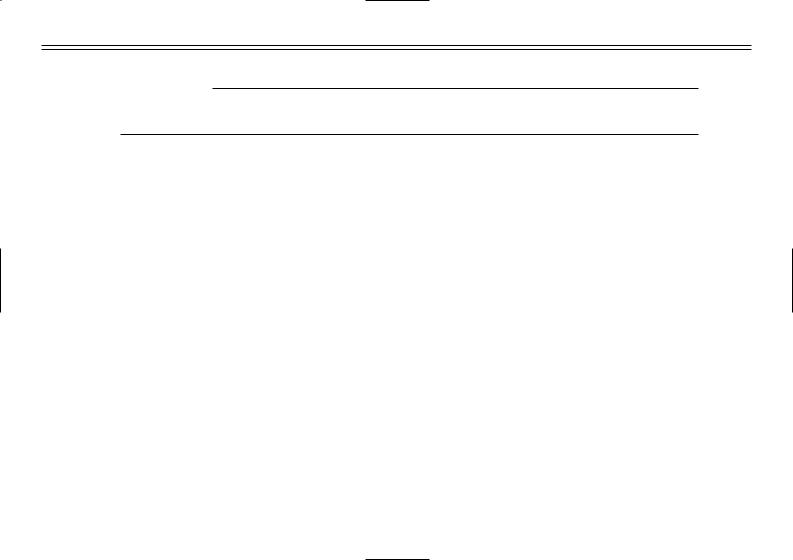
IMPORTANT MANUAL INFORMATION
EW000002
w
PLEASE READ THIS MANUAL CAREFULLY AND COMPLETELY BEFORE OPERATING THIS MOTORCYCLE.
1
2
4
5
6
7
8
9

1
2
3
4
5
6
7
8
9
EAU03337
DT230 (N)
OWNER’S MANUAL ©2000 by Yamaha Motor Co., Ltd.
1st Edition, July 2000 All rights reserved.
Any reprinting or unauthorized use without the written permission of Yamaha Motor Co., Ltd.
is expressly prohibited. Printed in Japan.

EAU00009
TABLE OF CONTENTS
1 |
.....................................SAFETY INFORMATION |
1-1 |
|
|
.........................................................Safe riding |
1-1 |
|
|
Protective apparel............................................. |
1-3 |
|
|
Modification....................................................... |
1-3 |
|
|
Loading and accessories .................................. |
1-3 |
|
|
Gasoline and exhaust gas ................................ |
1-5 |
|
|
Location of important labels.............................. |
1-7 |
|
|
DESCRIPTION |
2-1 |
|
2 |
|||
Left view............................................................ |
2-1 |
||
|
|||
|
Right view ......................................................... |
2-2 |
|
|
Controls and instruments.................................. |
2-3 |
|
|
INSTRUMENT AND CONTROL FUNCTIONS |
3-1 |
|
3 |
|||
Main switch/steering lock.................................. |
3-1 |
||
|
|||
|
Indicator and warning lights .............................. |
3-2 |
|
|
Speedometer unit ............................................. |
3-3 |
|
|
Handlebar switches .......................................... |
3-5 |
|
|
Clutch lever....................................................... |
3-6 |
|
|
Shift pedal......................................................... |
3-6 |
|
|
Brake lever........................................................ |
3-6 |
|
|
Brake pedal....................................................... |
3-7 |
|
|
Fuel tank cap .................................................... |
3-7 |
|
|
Fuel................................................................... |
3-8 |
|
|
2-stroke engine oil ............................................ |
3-8 |
|
|
Fuel cock .......................................................... |
3-9 |
|
Starter (choke) lever “1”................................ |
3-10 |
|
|
Seat ................................................................ |
3-10 |
|
|
Helmet holder ................................................. |
3-11 |
|
|
Adjusting the front fork.................................... |
3-11 |
|
|
Adjusting the shock absorber assembly ......... |
3-12 |
|
|
YPVS .............................................................. |
3-15 |
|
|
Sidestand........................................................ |
3-16 |
|
|
Ignition circuit cut-off system .......................... |
3-16 |
|
|
PRE-OPERATION CHECKS |
4-1 |
|
4 |
|||
Pre-operation check list .................................... |
4-1 |
||
|
|||
|
OPERATION AND IMPORTANT RIDING |
|
|
5 |
|
||
POINTS................................................................ |
5-1 |
||
|
|||
|
Starting and warming up a cold engine ............ |
5-1 |
|
|
Starting a warm engine..................................... |
5-2 |
|
|
Shifting.............................................................. |
5-2 |
|
|
Tips for reducing fuel consumption................... |
5-3 |
|
|
Engine break-in................................................. |
5-3 |
|
|
Parking.............................................................. |
5-4 |
|
|
PERIODIC MAINTENANCE AND MINOR |
|
|
6 |
|
||
REPAIR................................................................ |
6-1 |
||
|
|||
|
Owner’s tool kit ................................................. |
6-1 |
|
|
Periodic maintenance and lubrication chart...... |
6-2 |
|
|
Removing and installing cowlings..................... |
6-5 |
1
2
3
4
5
6
7
8
9
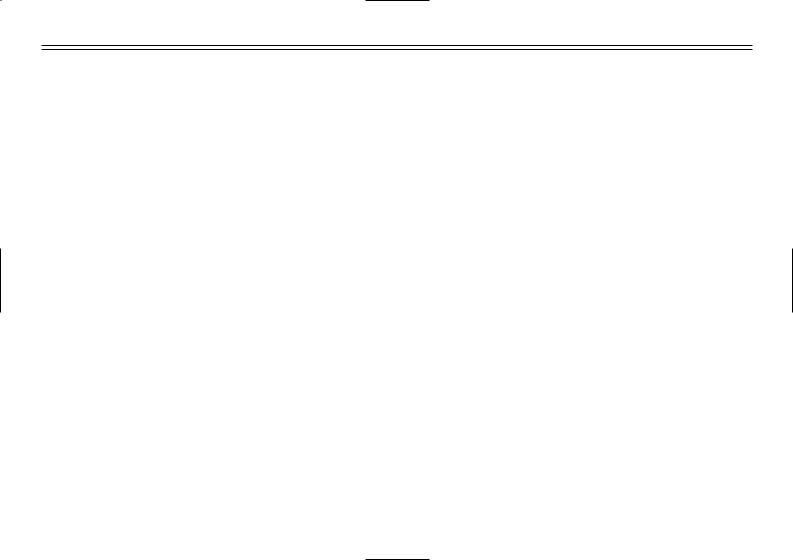
1
2
3
4
5
6
7
8
9
TABLE OF CONTENTS
Removing and installing panels ........................ |
6-6 |
Checking the spark plug ................................... |
6-7 |
Transmission oil................................................ |
6-9 |
Coolant ........................................................... |
6-10 |
Changing the coolant...................................... |
6-12 |
Cleaning the air filter element ......................... |
6-14 |
Adjusting the carburetor.................................. |
6-15 |
Adjusting the engine idling speed ................... |
6-16 |
Adjusting the throttle cable free play............... |
6-16 |
Tires................................................................ |
6-17 |
Spoke wheels ................................................. |
6-20 |
Adjusting the clutch lever free play ................. |
6-20 |
Adjusting the brake lever free play ................. |
6-21 |
Adjusting the brake pedal position.................. |
6-22 |
Adjusting the rear brake light switch ............... |
6-23 |
Checking the front and rear brake pads ......... |
6-23 |
Checking the brake fluid level......................... |
6-24 |
Changing the brake fluid................................. |
6-25 |
Drive chain slack............................................. |
6-25 |
Lubricating the drive chain.............................. |
6-26 |
Checking and lubricating the cables ............... |
6-27 |
Checking and lubricating the throttle grip and |
|
cable ............................................................. |
6-28 |
Adjusting the Autolube pump.......................... |
6-28 |
Checking and lubricating the brake and shift |
|
pedals ........................................................... |
6-29 |
|
Checking and lubricating the brake and clutch |
||
|
levers ............................................................ |
6-29 |
|
|
Checking and lubricating the sidestand .......... |
6-29 |
|
|
Lubricating the rear suspension...................... |
6-30 |
|
|
Checking the front fork.................................... |
6-30 |
|
|
Checking the steering ..................................... |
6-31 |
|
|
Checking the wheel bearings.......................... |
6-31 |
|
|
Battery ............................................................ |
6-32 |
|
|
Replacing the fuse .......................................... |
6-33 |
|
|
Replacing the headlight bulb .......................... |
6-34 |
|
|
Replacing a turn signal light bulb.................... |
6-36 |
|
|
Replacing the tail/brake light bulb................... |
6-37 |
|
|
Replacing the license plate light bulb ............. |
6-37 |
|
|
Supporting the motorcycle .............................. |
6-38 |
|
|
Front wheel ..................................................... |
6-39 |
|
|
Rear wheel...................................................... |
6-40 |
|
|
Troubleshooting .............................................. |
6-42 |
|
|
Troubleshooting charts ................................... |
6-43 |
|
|
MOTORCYCLE CARE AND STORAGE |
7-1 |
|
7 |
|||
Care .................................................................. |
7-1 |
||
|
|||
|
Storage ............................................................. |
7-4 |
|
|
SPECIFICATIONS |
8-1 |
|
8 |
|||
How to use the conversion table....................... |
8-5 |
||
|
|||
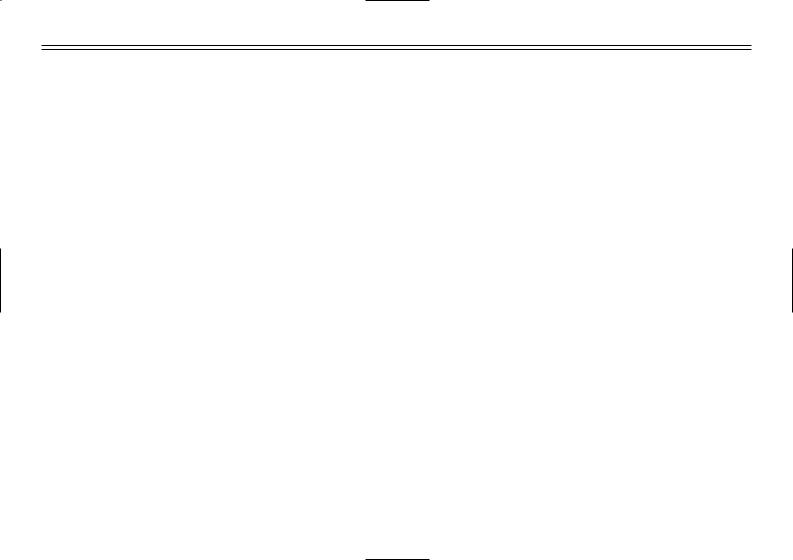
TABLE OF CONTENTS
9 |
..............................CONSUMER INFORMATION |
9-1 |
|
...........................Identification numbers record |
9-1 |
|
Key identification number ................................. |
9-1 |
|
Vehicle identification number............................ |
9-1 |
|
Model label ....................................................... |
9-2 |
|
Motorcycle noise regulation (for Australia) ....... |
9-2 |
1
2
3
4
5
6
7
8
9

1
2
3
4
5
6
7
8
9
EAU00017
QSAFETY INFORMATION
MOTORCYCLES ARE SINGLE TRACK VEHICLES. THEIR SAFE USE AND OPERATION ARE DEPENDENT UPON THE USE OF PROPER RIDING TECHNIQUES AS WELL AS THE EXPERTISE OF THE OPERATOR. EVERY OPERATOR SHOULD KNOW THE FOLLOWING REQUIREMENTS BEFORE RIDING THIS MOTORCYCLE.
HE OR SHE SHOULD:
1.OBTAIN THOROUGH INSTRUCTIONS FROM A COMPETENT SOURCE ON ALL ASPECTS OF MOTORCYCLE OPERATION.
2.OBSERVE THE WARNINGS AND MAINTENANCE REQUIREMENTS IN THE OWNER’S MANUAL.
3.OBTAIN QUALIFIED TRAINING IN SAFE AND PROPER RIDING TECHNIQUES.
4.OBTAIN PROFESSIONAL TECHNICAL SERVICE AS INDICATED BY THE OWNER’S MANUAL AND/OR WHEN MADE NECESSARY BY MECHANICAL CONDITIONS.
Safe riding
1.Always make pre-operation checks. Careful checks may help prevent an accident.
2.This motorcycle is designed to carry the operator and a passenger.
3.The failure of motorists to detect and recognize motorcycles in traffic is the predominating cause of automobile/motorcycle accidents. Many accidents have been caused by an automobile driver who did not see the motorcycle. Making yourself conspicuous appears to be very effective in reducing the chance of this type of accident.
Therefore:
a.Wear a brightly colored jacket.
b.Use extra caution when approaching and passing through intersections, since intersections are the most likely places for motorcycle accidents to occur.
c.Ride where other motorists can see you. Avoid riding in another motorist’s blind spot.
1-1
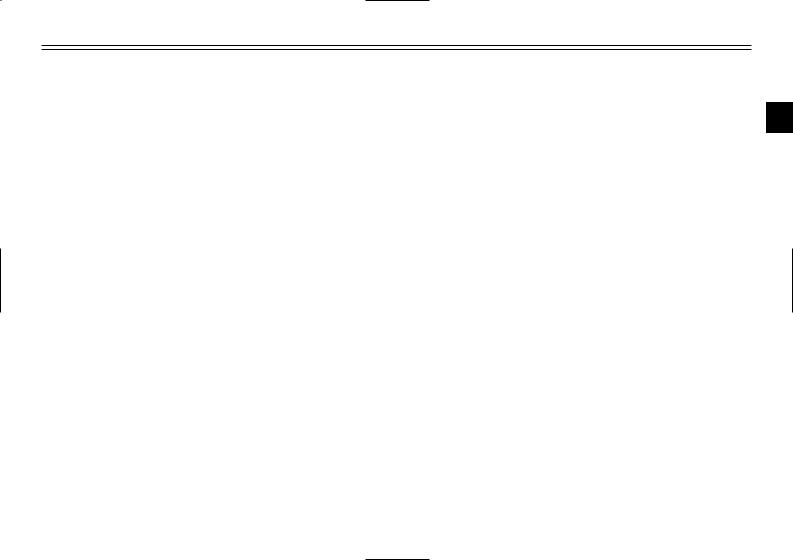
QSAFETY INFORMATION
4.Many accidents involve inexperienced operators. In fact, many operators who have been involved in accidents do not even have a current motorcycle license.
a. Make sure that you are qualified and that you only lend your motorcycle to other qualified oper-
ators.
b. Know your skills and limits. Staying within your limits may help you to avoid an accident.
c. We recommend that you practice riding your motorcycle where there is no traffic until you have become thoroughly familiar with the motorcycle and all of its controls.
5. Many accidents have been caused by error of the motorcycle operator. A typical error made by the operator is veering wide on a turn due to EXCESSIVE SPEED or undercornering (insufficient lean angle for the speed).
a. Always obey the speed limit and never travel faster than warranted by road and traffic conditions.
b. Always signal before turning or changing lanes. Make sure that other motorists can see you. 6. The posture of the operator and passenger is important for proper control.
a. The operator should keep both hands on the handlebar and both feet on the operator footrests during operation to maintain control of the motorcycle.
b. The passenger should always hold onto the operator, the seat strap or grab bar, if equipped, with both hands and keep both feet on the passenger footrests.
c. Never carry a passenger unless he or she can firmly place both feet on the passenger footrests.
7. Never ride under the influence of alcohol or other drugs.
1
2
3
4
5
6
7
8
9
1-2

1
2
3
4
5
6
7
8
9
QSAFETY INFORMATION
Protective apparel
The majority of fatalities from motorcycle accidents are the result of head injuries. The use of a safety helmet is the single most critical factor in the prevention or reduction of head injuries.
1.Always wear an approved helmet.
2.Wear a face shield or goggles. Wind in your unprotected eyes could contribute to an impairment
of vision that could delay seeing a hazard.
3.The use of a jacket, heavy boots, trousers, gloves, etc., is effective in preventing or reducing abrasions or lacerations.
4.Never wear loose-fitting clothes, otherwise they could catch on the control levers, footrests, or wheels and cause injury or an accident.
5.Never touch the engine or exhaust system during or after operation. They become very hot and can cause burns. Always wear protective clothing that covers your legs, ankles, and feet.
6.Passengers should also observe the precautions mentioned above.
Modifications
Modifications made to this motorcycle not approved by Yamaha, or the removal of original equipment, may render the motorcycle unsafe for use and may cause severe personal injury. Modifications may also make your motorcycle illegal to use.
Loading and accessories
Adding accessories or cargo to your motorcycle can adversely affect stability and handling if the weight distribution of the motorcycle is changed. To avoid the possibility of an accident, use extreme caution when adding cargo or accessories to your motorcycle. Use extra care when riding a motorcycle that has added cargo or accessories. Here are some general guidelines to follow if loading cargo or adding accessories to your motorcycle:
1-3
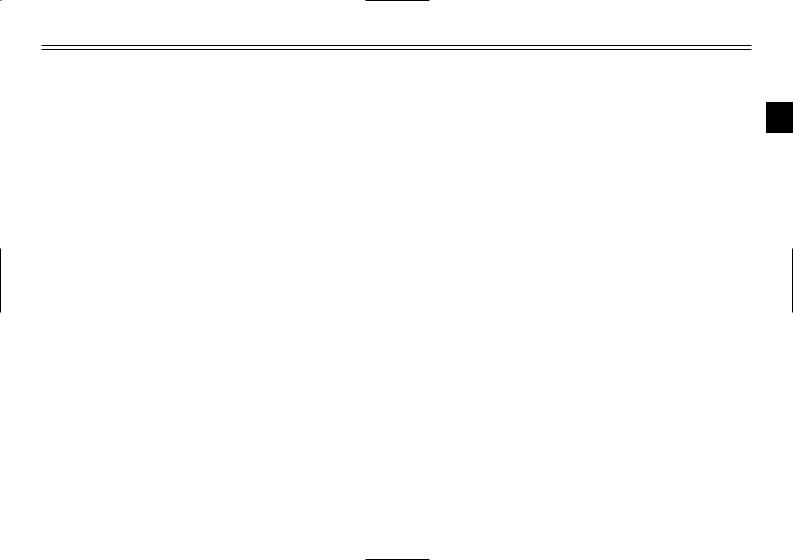
QSAFETY INFORMATION
Loading
The total weight of the operator, passenger, accessories and cargo must not exceed the maximum load limit of 180 kg. When loading within this weight limit, keep the following in mind:
1.Cargo and accessory weight should be kept as low and close to the motorcycle as possible. 1 Make sure to distribute the weight as evenly as possible on both sides of the motorcycle to mini-
mize imbalance or instability.
2.Shifting weights can create a sudden imbalance. Make sure that accessories and cargo are securely attached to the motorcycle before riding. Check accessory mounts and cargo restraints frequently.
3.Never attach any large or heavy items to the handlebar, front fork, or front fender. These items, including such cargo as sleeping bags, duffel bags, or tents, can create unstable handling or a slow steering response.
Accessories
2
3
4
5
Genuine Yamaha accessories have been specifically designed for use on this motorcycle. Since |
6 |
Yamaha cannot test all other accessories that may be available, you must personally be responsible |
|
|
for the proper selection, installation and use of non-Yamaha accessories. Use extreme caution when |
7 |
|
selecting and installing any accessories. |
||
|
||
Keep the following guidelines in mind, as well as those provided under “Loading” when mounting |
8 |
|
accessories. |
||
|
||
|
9 |
1-4
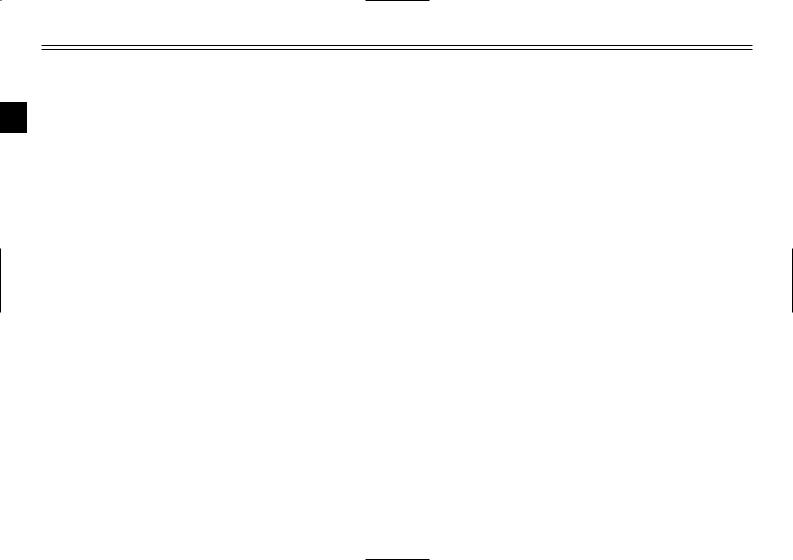
1
2
3
4
5
6
7
8
9
QSAFETY INFORMATION
1.Never install accessories or carry cargo that would impair the performance of your motorcycle. Carefully inspect the accessory before using it to make sure that it does not in any way reduce ground clearance or cornering clearance, limit suspension travel, steering travel or control opera-
tion, or obscure lights or reflectors.
a.Accessories fitted to the handlebar or the front fork area can create instability due to improper weight distribution or aerodynamic changes. If accessories are added to the handlebar or front fork area, they must be as lightweight as possible and should be kept to a minimum.
b.Bulky or large accessories may seriously affect the stability of the motorcycle due to aerodynamic effects. Wind may attempt to lift the motorcycle, or the motorcycle may become unstable in cross winds. These accessories may also cause instability when passing or being passed by large vehicles.
c.Certain accessories can displace the operator from his or her normal riding position. This improper position limits the freedom of movement of the operator and may limit control ability, therefore, such accessories are not recommended.
2.Use caution when adding electrical accessories. If electrical accessories exceed the capacity of the motorcycle’s electrical system an electric failure could result, which could cause a dangerous
loss of lights or engine power.
Gasoline and exhaust gas
1.GASOLINE IS HIGHLY FLAMMABLE:
a.Always turn the engine off when refueling.
b.Take care not to spill any gasoline on the engine or exhaust system when refueling.
c.Never refuel while smoking or in the vicinity of an open flame.
1-5

QSAFETY INFORMATION
2.Never start the engine or let it run for any length of time in a closed area. The exhaust fumes are poisonous and may cause loss of consciousness and death within a short time. Always operate your motorcycle in an area that has adequate ventilation.
3.Always turn the engine off before leaving the motorcycle unattended and remove the key from the main switch. When parking the motorcycle, note the following:
a.The engine and exhaust system may be hot, therefore, park the motorcycle in a place where pedestrians or children are not likely to touch these hot areas.
b.Do not park the motorcycle on a slope or soft ground, otherwise it may fall over.
c.Do not park the motorcycle near a flammable source (e.g., a kerosene heater, or near an open flame), otherwise it could catch fire.
4.When transporting the motorcycle in another vehicle, make sure that it is kept upright and that the fuel cock(s) are turned to “ON” or “RES” (for vacuum type)/”OFF” (for manual type). If the motorcycle should lean over, gasoline may leak out of the carburetor or fuel tank.
5.If you should swallow any gasoline, inhale a lot of gasoline vapor, or allow gasoline to get into your eyes, see your doctor immediately. If any gasoline spills on your skin or clothing, immediately wash the affected area with soap and water and change your clothes.
1
2
3
4
5
6
7
8
9
1-6
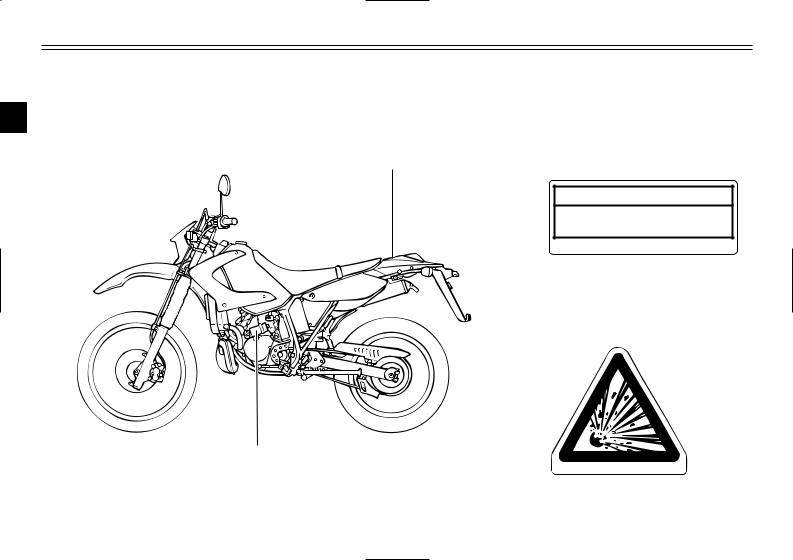
1
2
3
4
5
6
7
8
9
QSAFETY INFORMATION
EAU02977
Location of important labels
Please read the following important labels carefully before operating this motorcycle.
1
1
WARNING
Before you operate this vehicle, read the owner’s manual.
English |
3HP-21568-00 |
2
2
4AA-22259-40
1-7
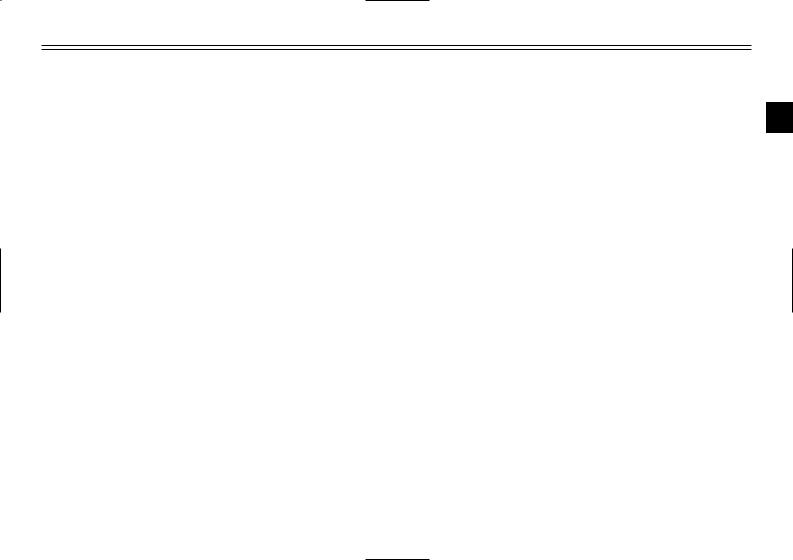
1
2
3
4
5
6
7
8
9
1-8
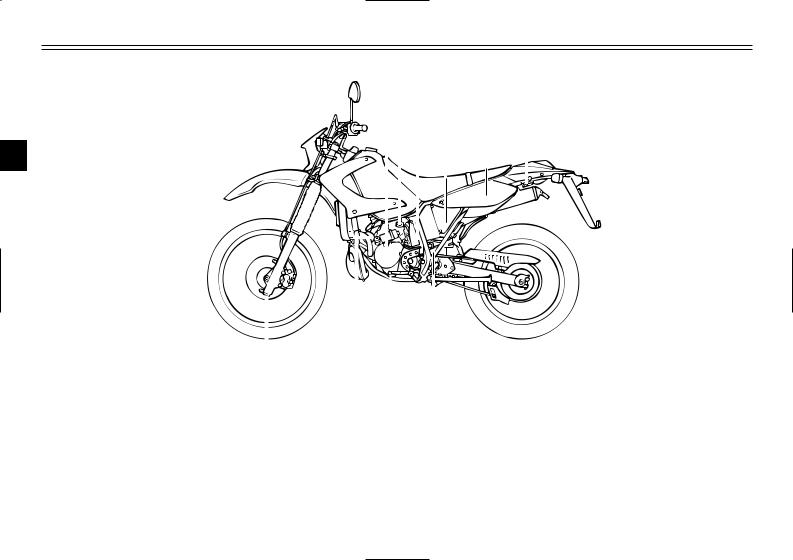
1
2
3
4
5
6
7
8
9
EAU00026
DESCRIPTION
Left view
1 |
2 3 |
4 |
5 |
6 |
7 |
|
|
|
|
|
|
|
|
|
|
|
|
|
|
|
|
|
|
|
|
|
|
|
|
|
|
|
|
|
|
|
|
|
|
|
|
|
|
|
|
|
|
|
|
|
|
|
|
|
|
|
|
|
|
|
|
|
|
|
|
|
|
|
|
|
|
|
|
|
|
|
|
|
|
|
|
|
|
|
|
|
|
|
|
|
|
|
|
|
|
|
|
|
|
|
|
|
|
|
|
|
|
|
|
|
|
|
|
|
|
|
|
|
|
|
|
|
|
|
|
|
|
|
|
|
|
|
|
|
|
|
|
|
|
|
|
|
|
|
|
|
|
|
|
|
|
|
|
|
|
|
|
|
|
|
|
|
|
|
|
|
|
|
|
|
|
|
|
|
|
|
|
|
|
|
|
|
|
|
|
|
|
|
|
|
|
|
|
|
|
|
|
|
|
|
|
|
|
|
|
|
|
|
|
|
|
|
|
|
|
|
|
|
|
|
|
|
|
|
|
|
12 |
11 |
|
10 |
|
|
|
9 |
8 |
|
|
|
|||||||
1. |
Headlight |
(page 6-34) |
8. |
Rear shock absorber spring preload |
|
||||||||||||||
2. |
Rear shock absorber compression |
|
|
|
|
|
|
|
|
|
|
|
adjusting nut |
(page 3-13) |
|||||
|
damping adjusting knob |
(page 3-14) |
9. |
Rear shock absorber rebound damping |
|
||||||||||||||
3. |
Fuel cock |
(page 3-9) |
|
|
|
|
|
|
|
adjusting dial |
(page 3-14) |
||||||||
4. |
Starter (choke) lever “1” |
(page 3-10) |
10. |
Shift pedal |
(page 3-6) |
||||||||||||||
5. |
Air filter element |
(page 6-14) |
11. |
YPVS |
(page 3-15) |
||||||||||||||
6. |
2-stroke engine oil tank |
(page 3-8) |
12. |
Front fork compression damping |
|
||||||||||||||
7. |
Helmet holder |
(page 3-11) |
|
|
|
|
|
|
|
adjusting screw |
(page 3-12) |
||||||||
2-1

DESCRIPTION
Right view
|
|
13 |
14 |
15 |
16 |
|
17 |
|
|||||
|
|
|
|
|
|
|
|
|
|
|
|
1 |
|
|
|
|
|
|
|
|
|
|
|
|
|
|
|
|
|
|
|
|
|
|
|
|
|
|
|
|
|
|
|
|
|
|
|
|
|
|
|
|
|
|
2 |
|
|
|
|
|
|
|
|
|
|
|
|
|
|
|
|
|
|
|
|
|
|
|
|
|
|
|
|
|
|
|
|
|
|
|
|
|
|
|
3 |
||
|
|
|
|
|
|
|
|
|
|
|
|||
|
|
|
|
|
|
|
|
|
|
|
4 |
||
|
|
|
|
|
|
|
|
|
|
|
5 |
||
|
|
|
|
|
|
|
|
|
|
|
6 |
||
|
|
|
|
|
|
|
|
|
|
|
|||
|
|
|
|
|
|
|
|
|
|
|
|||
|
|
|
|
|
|
|
|
|
|
|
7 |
||
|
|
|
|
|
|
|
|
18 |
|||||
|
|
|
|
|
|
|
|
|
|
|
|||
13. |
Coolant reservoir |
|
(page 6-11) |
|
|
|
8 |
||||||
14. |
Owner’s tool kit |
|
(page 6-1) |
|
|
|
|
|
|
||||
15. |
Battery |
|
(page 6-32) |
|
|
|
9 |
||||||
16. |
Fuse |
|
(page 6-33) |
|
|
|
|
|
|
||||
17. |
Radiator cap |
|
(page 6-12) |
|
|
|
|
|
|
||||
18. |
Brake pedal |
|
(page 3-7, 6-22) |
|
|
|
|||||||
2-2

1
2
3
4
5
6
7
8
9
DESCRIPTION
Controls and instruments
1 |
2 |
3 |
4 |
5 |
6 |
|
|
|
|
|
|
|
|
|
|
|
|
|
|
|
|
|
|
|
|
|
|
|
|
|
|
|
|
|
|
|
|
|
|
|
|
|
|
|
|
|
|
|
|
|
|
|
|
|
|
|
|
|
|
|
|
|
|
|
|
|
|
|
|
|
|
|
|
|
|
|
|
|
|
|
|
|
|
|
|
|
|
|
|
|
|
|
|
|
|
|
|
|
|
|
|
|
|
|
|
|
|
|
8 |
|
|
7 |
|||
1. |
Clutch lever |
(page 3-6, 6-20) |
6. |
Brake lever |
|
|
(page 3-6, 6-21) |
|||
2. |
Left handlebar switches |
(page 3-5) |
7. |
Throttle grip |
|
|
(page 6-16, 6-28) |
|||
3. |
Speedometer unit |
(page 3-3) |
8. |
Fuel tank cap |
|
|
(page 3-7) |
|||
4. |
Main switch/steering lock |
(page 3-1) |
|
|
|
|
|
|
|
|
5. |
Right handlebar switches |
(page 3-5) |
|
|
|
|
|
|
|
|
2-3

EAU00027
OFF |
ON |
|
||
|
|
F |
ON |
|
|
|
|
|
|
|
|
F |
|
|
S |
H |
O |
|
|
|
|
|
|
|
U |
|
|
|
|
P |
|
|
|
|
L |
|
|
|
|
O |
|
|
N |
|
K |
|
|||
C |
|
|
||
|
|
|
IO |
|
LOCK |
|
|
IT |
|
|
|
IGN |
|
|
|
|
|
|
|
EAU00029
Main switch/steering lock
The main switch/steering lock controls the ignition and lighting systems, and is used to lock the steering. The various positions are described below.
EAU00031
ON
All electrical systems are supplied with power, and the headlight, meter lighting, taillight and license plate light come on, and the engine can be started. The key cannot be removed.
EAU00038
OFF
All electrical systems are off. The key can be removed.
INSTRUMENT AND CONTROL FUNCTIONS
EW000016
w
Never turn the key to “OFF” or “LOCK” while the motorcycle is moving, otherwise the electrical systems will be switched off, which may result in loss of control or an accident. Make sure that the motorcycle is stopped before turning the key to “OFF” or “LOCK”.
EAU00040
LOCK
The steering is locked, and all electrical systems are off. The key can be removed.
To lock the steering
1.Turn the handlebars all the way to the left.
2.Push the key in from the “OFF” position, and then turn it to “LOCK” while still pushing it.
3.Remove the key.
To unlock the steering
Push the key in, and then turn it to “OFF” while still pushing it.
1
2
3
4
5
6
7
8
9
3-1
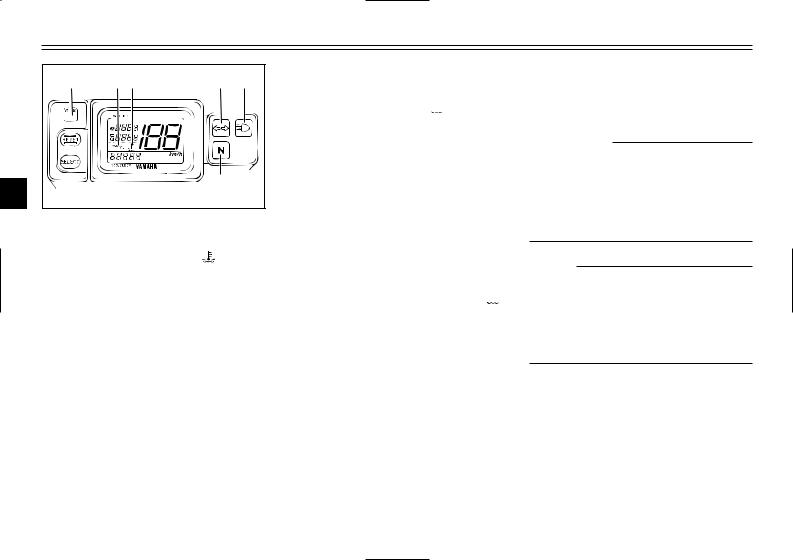
INSTRUMENT AND CONTROL FUNCTIONS
1 |
2 3 |
4 |
5 |
1 |
|
|
|
2 |
|
|
|
3 |
|
6 |
|
|
|
|
4 |
1. |
Oil level/coolant temperature warning |
|
light “WARNING” |
|
|
2. |
Oil level symbol “7” |
5 |
3. |
Coolant temperature symbol “ ” |
4. |
Turn signal indicator light “5” |
|
|
5. |
High beam indicator light “&” |
|
6. |
Neutral indicator light “N” |
6 EAU03034
Indicator and warning lights
7
EAU03587
Oil level/coolant temperature
8warning light “WARNING”
This warning light has the following
9three functions.
8When the engine oil level is low, the warning light comes on and symbol “7” flashes. If this occurs, stop the engine immediately and add engine oil to the specified level.
8When the coolant temperature is too high, the warning light comes on and symbol “ 
 ” flashes. Stop the motorcycle and allow it to idle until the coolant temperature goes down. If the temperature does not go down, stop the engine. (See the “Engine overheating” section on page 6-44 for further instructions.)
” flashes. Stop the motorcycle and allow it to idle until the coolant temperature goes down. If the temperature does not go down, stop the engine. (See the “Engine overheating” section on page 6-44 for further instructions.)
8When the engine oil level is low and the coolant temperature is too high, the warning light flashes and symbols “7” and “ 
 ” come on.
” come on.
To check that the warning light is working properly:
8Put the transmission in neutral or apply the clutch lever.
8Turn the engine stop switch to “#” and the key to “ON”.
8The light will come on and symbol “7” will appear in the display.
If the warning light does not come on, have a Yamaha dealer inspect the electrical circuit.
EC000118
cC
8Do not operate the motorcycle until you know that the engine oil level is sufficient.
8Do not operate the engine if it is overheated.
NOTE:
Even if the oil is filled to the specified level, the indicator light may flicker when riding on a slope or during sudden acceleration or deceleration, but this is normal.
EAU00057
Turn signal indicator light “ 5”
This indicator light flashes when the turn signal switch is pushed to the left or right.
3-2

INSTRUMENT AND CONTROL FUNCTIONS
1 |
2 3 |
4 |
5 |
|
|
6 |
|
1.Oil level/coolant temperature warning light “WARNING”
2.Oil level symbol “7”
3.Coolant temperature symbol “
 ”
”
4.Turn signal indicator light “5”
5.High beam indicator light “&”
6.Neutral indicator light “N”
EAU00063
High beam indicator light “ &”
This indicator light comes on when the high beam of the headlight is switched on.
EAU00061
Neutral indicator light “N”
This indicator light comes on when the transmission is in the neutral position.
1 |
2 3 |
4 |
6 |
5 |
|
1.Reset button “RESET”
2.Upper trip odometer
3.Lower trip odometer
4.Digital speedometer
5.Odometer/Clock “ODO/CLOCK”
6.Mode select button “SELECT”
EAU00100
Speedometer unit
The speedometer unit is equipped with a digital speedometer, an odometer, two tripmeters and a clock. The speedometer shows riding speed. The odometer shows the total distance traveled. The tripmeter shows the distance traveled since it was last set to zero.
The mode select button is used to switch between modes “A” and “B”.
When in mode “A”:
8The upper tripmeter can be reset to zero.
8The display can be switched between the clock and the odometer.
8The clock can be set.
When in mode “B”:
8The lower tripmeter can be reset.
8The lower tripmeter can be switched between forward count and reverse count.
Select the modes as follows: 1. Turn the key to “ON”.
1
2
3
4
5
6
7
8
9
3-3

INSTRUMENT AND CONTROL FUNCTIONS
|
1 |
2 3 |
4 |
1 |
|
|
|
2 |
|
|
|
3 |
6 |
5 |
|
4 |
1. |
Reset button “RESET” |
2. |
Upper trip odometer |
|
|
3. |
Lower trip odometer |
5 |
4. |
Digital speedometer |
5. |
Odometer/Clock “ODO/CLOCK” |
|
|
6. |
Mode select button “SELECT” |
6 NOTE:
When the key is turned to “ON”, the
7speedometer displays “188 km/h” for a few seconds, during which time the
electrical circuit is being checked.
8
2. Push the mode select button to
9
display a mode.
Mode “A”
To set the upper tripmeter to zero, push the reset button for at least one second.
To display the clock or odometer reading, push the mode select button for one to three seconds.
To set the clock:
1.Push the mode select button until the hour digits flash.
2.Push the reset button to change the hour digits.
3.Push the mode select button, and the minute digits will flash.
4.Push the reset button to change the minute digits.
5.Push the mode select button again to set the clock.
Mode “B”
To set the lower tripmeter to zero, push the reset button for at least one second.
To switch the tripmeter between forward count and reverse count, push the mode select button for one to three seconds. A minus sign – will appear when in the reverse count mode.
To set the reverse count distance:
1.Push the mode select button until the digit for the hundreds flashes.
2.Push the reset button to change the hundreds.
3.Repeat this procedure to change the tens and ones.
4.Push the mode select button again to set the tripmeter.
3-4

INSTRUMENT AND CONTROL FUNCTIONS
1 |
2 |
3 |
|
1.Dimmer switch
2.Turn signal switch
3.Horn switch “*”
EAU00118
Handlebar switches
EAU00121
Dimmer switch
Set this switch to “&” for the high beam and to “%” for the low beam.
EAU00127
Turn signal switch
To signal a right-hand turn, push this switch to “6”. To signal a left-hand turn, push this switch to “4”. When released, the switch returns to the center position. To cancel the turn signal lights, push the switch in after it has returned to the center position.
EAU00129
Horn switch “ *”
Press this switch to sound the horn.
|
1 |
|
1 |
|
2 |
2 |
3 |
1. |
Engine stop switch |
|
4 |
|
2. |
Start switch “,” |
|
||
|
|
|||
|
|
EAU00138 |
|
|
Engine stop switch |
|
5 |
||
Set this switch to “$” to stop the |
|
|||
engine in case of |
an emergency, |
6 |
||
such as when the motorcycle over- |
||||
|
||||
turns or when the |
throttle cable is |
7 |
||
stuck. |
|
|||
|
|
|||
|
|
EAU00143 |
|
|
Start switch “ ,” |
|
8 |
||
Push this switch to crank the engine |
|
|||
with the starter. |
|
9 |
||
|
|
EC000005 |
|
|
cC
See page 5-1 for starting instructions prior to starting the engine.
3-5
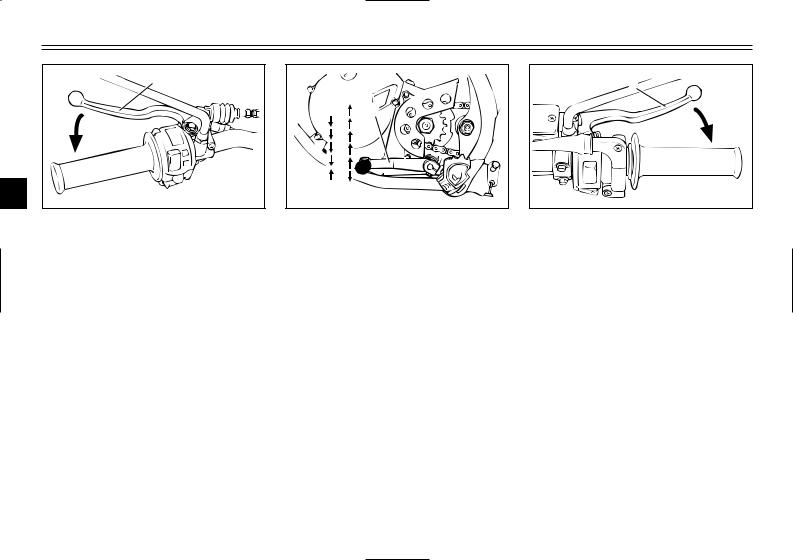
INSTRUMENT AND CONTROL FUNCTIONS
1 |
1 |
2 |
3 |
1. Clutch lever
4
|
|
EAU00152 |
|
5 |
Clutch lever |
|
|
The clutch lever is located at the left |
|||
|
|||
6 |
handlebar grip. |
To disengage the |
|
clutch, pull the lever toward the han- |
|||
|
dlebar grip. To |
engage the clutch, |
|
7release the lever. The lever should be pulled rapidly and released slowly
8for smooth clutch operation.
The clutch lever is equipped with a
clutch switch, which is part of the igni-
9
tion circuit cut-off system. (See page 3-16 for an explanation of the ignition circuit cut-off system.)
 6 1 5
6 1 5
4
3
 2
2
N


1
1. Shift pedal N. Neutral
EAU00157
Shift pedal
The shift pedal is located on the left side of the engine and is used in combination with the clutch lever when shifting the gears of the 6-speed constant-mesh transmission equipped on this motorcycle.
1 |
1. Brake lever
EAU00158
Brake lever
The brake lever is located at the right handlebar grip. To apply the front brake, pull the lever toward the handlebar grip.
3-6

INSTRUMENT AND CONTROL FUNCTIONS
1 |
1. Brake pedal
EAU00162
Brake pedal
The brake pedal is on the right side of the motorcycle. To apply the rear brake, press down on the brake pedal.
b 1
a |
1. Fuel tank cap
a.Unlock
b.Open
EAU00177
Fuel tank cap
To remove the fuel tank cap
1.Insert the key into the lock and turn it 1/4 turn counterclockwise.
2.Turn the fuel tank cap 1/3 turn counterclockwise and pull it off.
To install the fuel tank cap
1.Insert the fuel tank cap into the tank opening with the key inserted in the lock, and then turn the cap 1/3 turn clockwise.
2.Turn the key 1/4 turn clockwise, and then remove it.
NOTE:
The fuel tank cap cannot be installed unless the key is in the lock. In addition, the key cannot be removed if the cap is not properly installed and locked.
EW000023
w
Make sure that the fuel tank cap is properly closed and locked before riding.
1
2
3
4
5
6
7
8
9
3-7
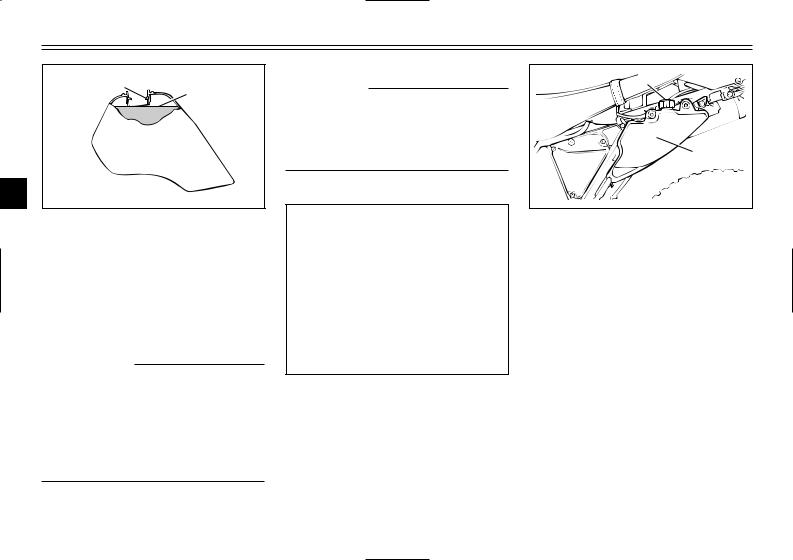
1
2
3
4
5
6
7
8
9
INSTRUMENT AND CONTROL FUNCTIONS
EAU00185
1 |
2 |
cC |
|
|
Immediately wipe off spilled fuel with a clean, dry, soft cloth, since fuel may deteriorate painted surfaces or plastic parts.
EAU00192
1.Filler tube
2.Fuel level
EAU01183
Fuel
Make sure that there is sufficient fuel in the tank. Fill the fuel tank to the bottom of the filler tube as shown in the illustration.
EW000130
w
8Do not overfill the fuel tank, otherwise it may overflow when the fuel warms up and expands.
8Avoid spilling fuel on the hot engine.
Recommended fuel: Regular gasoline
For Australia: Unleaded fuel only
Fuel tank capacity: Total amount:
11.0 L Reserve amount:
2.0 L
1 |
2 |
1.2-stroke engine oil tank cap
2.2-stroke engine oil tank
EAU01413
2-stroke engine oil
Make sure that there is sufficient oil in the 2-stroke engine oil tank. If necessary, add oil as follows.
1.Remove panel A. (See page 6-6 for panel removal and installation procedures.)
2.Remove the 2-stroke engine oil tank cap and add the recommended oil.
3.Install the 2-stroke engine oil tank cap and the panel.
3-8
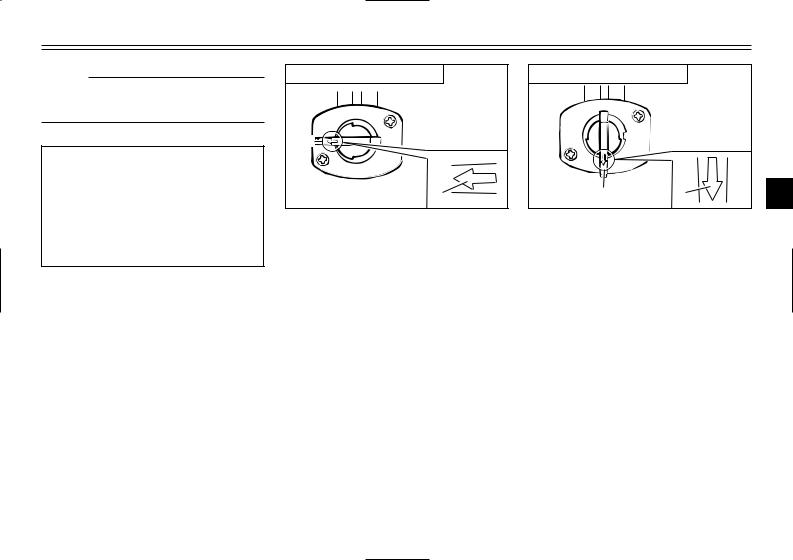
INSTRUMENT AND CONTROL FUNCTIONS
NOTE:
Make sure that the 2-stroke engine oil tank cap is properly closed.
Recommended oil: Yamalube 2 or equivalent 2-stroke engine oil (JASO grade “FC”)
Oil quantity: 1.3 L
OFF: Closed position |
RES |
OFF |
ON |
1 |
1. Arrow mark positioned over “OFF”
EAU03050
Fuel cock
The fuel cock supplies fuel from the tank to the carburetor while filtering it also.
The fuel cock has three positions:
OFF
With the lever in this position, fuel will not flow. Always return the lever to this position when the engine is not running.
ON: Normal position |
|
|
RES |
|
1 |
|
|
|
OFF |
|
|
ON |
FUEL |
2 |
|
|
|
ON |
1 |
3 |
1. Arrow mark positioned over “ON”
4
ON
With the lever in this position, fuel |
5 |
|
flows to the carburetor. Normal riding |
||
|
||
is done with the lever in this position. |
6 |
|
|
||
|
7 |
|
|
8 |
|
|
9 |
3-9

INSTRUMENT AND CONTROL FUNCTIONS
|
RES: Reserve position |
|
|
RES |
|
1 |
|
|
2 |
OFF |
|
|
UEL |
1 |
3 |
ON |
|
|
|
|
4 |
1. Arrow mark positioned over “RES” |
|
RES
5
This indicates reserve. If you run out
of fuel while riding, move the lever to this position. Fill the tank at the first 6 opportunity. Be sure to set the lever
back to “ON” after refueling!
7
8
a |
1 |
b |
1. Starter (choke) lever “1” |
EAU02976 |
Starter (choke) lever “ 1”
Starting a cold engine requires a richer air-fuel mixture, which is supplied by the starter (choke).
Move the lever in direction a to turn on the starter (choke).
Move the lever in direction b to turn off the starter (choke).
1 |
1. Bolt (×2) |
EAU00240 |
Seat |
To remove the seat
Remove the bolts, and then pull the seat off.
9
3-10

INSTRUMENT AND CONTROL FUNCTIONS
|
1 |
|
2 |
1. |
Projection (×2) |
2. |
Seat holder (×2) |
To install the seat
1.Insert the projections on the front of the seat into the seat holders as shown.
2.Place the seat in the original position, and then tighten the bolts.
NOTE:
Make sure that the seat is properly secured before riding.
|
|
|
EAU03589 |
1 |
|
Adjusting the front fork |
|
|
This front fork is equipped with damp- |
||
a |
|
ing force adjusting screws. |
|
|
|
EW000035 |
|
|
|
w |
|
|
|
Always adjust both fork legs |
|
|
|
equally, otherwise poor handling |
|
|
|
and loss of stability may result. |
|
|
|
|
|
1. Helmet holder a. Open
EAU00260
Helmet holder
To open the helmet holder, insert the key into the lock, and then turn the key as shown.
To lock the helmet holder, place it in the original position, and then remove the key.
EW000030
w
Never ride with a helmet attached to the helmet holder, since the helmet may hit objects, causing loss of control and possibly an accident.
1
2
3
4
5
6
7
8
9
3-11
